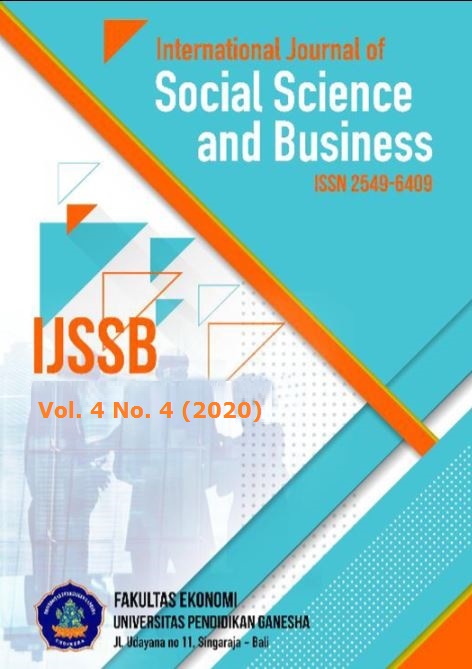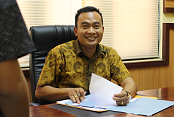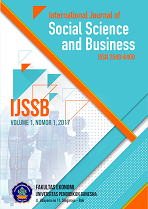Exploring the Values of Local Wisdom as Sustainable Tourism Attractions
DOI:
https://doi.org/10.23887/ijssb.v4i4.29178Keywords:
tourism, local wisdom, value, sustainableAbstract
Sustainable tourism is a concept that is aspired to be realized in the tourism industry so that natural and cultural resources can be preserved and enjoyed for generations to come. This research explores a variety of tourist attractions based on local wisdom values as an effort to create sustainable tourism. Kampung Banceuy is one of the traditional villages that has various values of local wisdom which is still preserved today and is able to attract many tourists. The method used in this research is an explorative qualitative approach. The data collection technique is done by direct observation, interviews, and documentation. Data analysis techniques were carried out in an interactive way and continued until completion, so that the data was saturated. The informants in this study were 9 people consisting of traditional leaders, communities, tourism managers, and tourists. The results showed that the value of local wisdom that can be a tourist attraction is village celebration events, cultural festivals, natural tourist attractions, and community life that has educational value. These various tourist attractions are not only oriented towards economic benefits but also act as a medium for the conservation of noble socio-cultural and environmental values as well as having educational value for tourists through the experience of tourism activities. The practice of the value of local wisdom that is still maintained is expected to always be passed on to the younger generation and can be of benefit to many parties, therefore this tourism activity always requires support from various parties.
References
Adom, D. (2019). The place and voice of local people, culture, and traditions: A catalyst for ecotourism development in rural communities in Ghana. Scientific African, 6. https://doi.org/10.1016/j.sciaf.2019.e00184
Aref, F., & Gill, S. S. (2009). Rural tourism development through rural cooperatives. Nature and Science, 7(10), 68–73. https://www.researchgate.net/profile/Sarjit_Gill/publication/305397865_Rural_tourism_development_through_rural_cooperatives/links/5f3cf0c0a6fdcccc43d32dac/Rural-tourism-development-through-rural-cooperatives.pdf
Balmford, A., Beresford, J., & Green, J. (2009). A global perspective on trends in nature-based tourism. PLoS Biol, 7. https://doi.org/10.1371/journal.pbio.1000144
Benckendorff, P. (2001). Planning For The Future A Study of Australian Tourist Attractions. James Cook.
Buhalis, D. (2000). Marketing the Competitive Destination of the Future. Tourism Management, 21(1), 97–116. https://doi.org/10.1016/S0261-5177(99)00095-3
Burkart, A., & Medlik, S. (2009). Tourism: Past, Present and Future. Heinemann.
Chaiphar, W., Sakolnakorn, P. N., T., & Naipinit, A. (2013). Local Wisdom in the Environmental Management of a Community: Analysis of Local Knowledge in Tha Pong Village, Thailand. Journal of Sustainable Development, 6(8), 16–25. https://www.cabdirect.org/cabdirect/abstract/20143030338
Creswell, J. W. (2017). Research Design. Pustaka Pelajar.
Darmadi, H. (2018). Educational Management Based On Local Wisdom (Descriptive Analytical Studies Of Culture Of Local Wisdom In West Kalimantan). Journal Of Education, Teaching And Learning, 3(1), 135–145. https://www.learntechlib.org/p/209101/
Getz, D. (2018). Event Management & Event Tourism (2nd ed.). Cognizant Communication Corporation.
Goeldner, R. C., & Ritchie, B. J. R. (2009). Tourism: Principles, Practices, and philosophies (11th ed.). John Willey and Son.
Hall, C. M., & Härkönen, T. (2006). Lake Tourism: An Integrated Approach to Lacustrine Tourism Systems. Channel View Press.
Higgins, F. (2017). Event Tourism and Event Imposition: A Critical Case Study From Kangaroo Island, South Australia. Journal Tourism Management, 64, 73–86. https://doi.org/10.1016/j.tourman.2017.08.002
Ivanovic, M. (2008). Cultural tourism. Juta.
Jimura, T. (2011). The impact of world heritage site designation on local communities - A case study of Ogimachi, Shirakawa-mura, Japan. Tourism Management, 32(2), 288–296. https://doi.org/10.1016/j.tourman.2010.02.005.
Khound, J. M. (2013). Constraints and prospects of rural tourism development: An overview of tourism in Shyamgaon of Titabor of Jorhat, District (Assam). Journal of Tourism and Hospitality Management, 1(1), 27–31. http://jthmnet.com/journals/jthm/Vol_1_No_1_December_2013/4.pdf
Kotler, P., Bowen, J. T., & Makens, J. C. (2014). Marketing For Hospitality And Tourism (6th ed.). Pearson International.
Lussetyowati, T. (2015). Preservation and Conservation through Cultural Heritage Tourism. Case Study: Musi Riverside Palembang. Procedia - Social and Behavioral Sciences, 184, 401–406. https://doi.org/10.1016/j.sbspro.2015.05.109
MacDonald, R., & Jolliffe, L. (2003). Cultural rural tourism: Evidence from Canada. Annals of Tourism Research, 30(2), 307–322. https://doi.org/10.1016/S0160-7383(02)00061-0
Malhotra, N. K. (2004). Marketing Research: An Applied Orientation (4th ed.). Pearson Education Inc.
Miles, M. ., & Huberman, A. M. (2014). Qualitative Data Analysis, A Methods Sourcebook (3rd ed.). Sage Publications.
Mill, R. C. (2000). Tourism The International Bussines. Raja Grafindo Persada.
Mill, R., & Morrison, A. (2015). The Tourism System, An Introductory Text. Prentice Hall Inc.
Mirza, N. (2016). The Impact of Cultural Heritage on Sustainable Tourism Development: The Case of Bergama (Pergamon). Journal of Tourism and Gastronomy Studies, 4(3), 60–66. https://www.jotags.org/2016/vol4_issue3_full_issue.pdf#page=72
Moleong, J. (2017). Metodologi Penelitian Kualitatif. Pt Remaja Rosdakarya.
Monz, C. A., Pickering, C. M., & Hadwen, W. L. (2013). Recent advances in recreation ecology and the implications of different relationships between recreation use and ecological impacts. Frontiers in Ecology and the Environment, 11, 441–446. https://doi.org/10.1890/120358
Richards, G. (2018). Cultural tourism: A review of recent research and trends. Journal of Hospitality and Tourism Management, 36, 12–21. https://doi.org/10.1016/j.jhtm.2018.03.005
Ritchie, B. W. (2003). Managing Educational Tourism. Channel View Publications.
Ritchie, B. W., Burns, P., & Catherine. (2005). Tourism Research Methods:Integrating. Theory with Practice Palmer. CABI Publishing.
Rodger. (2013). Leisure, Learning and Travel. Journal of Physical Education, 69(4), 28–31. https://doi.org/10.1080/07303084.1998.10605532
Sangchumnong, A. (2018). Development of a sustainable tourist destination based on the creative economy: A case study of Klong Kone Mangrove Community, Thailand. Kasetsart Journal of Social Sciences, 40(3). https://so04.tci-thaijo.org/index.php/kjss/article/view/242302
Sharma, A. (2015). Educational Tourism : Strategy for Sustainable Tourism Development with reference of Hadauti and Shekhawati Regions. Journal of Knowledge Management, Economics and Information Technology, 5(4), 1–17. https://ideas.repec.org/a/jbu/jbeitt/1425.html
Sibarani, R. (2018). Batak Toba society’s local wisdom of mutual cooperation in Toba Lake area: a linguistic anthropology study. International Journal of Human Rights in Healthcare, 11(1), 40–55. https://doi.org/10.1108/IJHRH-08-2017-0035
Sinclair-Maragh, G. (2012). Denbigh Showground: a potential “agri-cultural” attraction concept for tourism in Jamaica. Emerald Emerging Markets Case Studies, 2(8), 1–17. https://doi.org/10.1108/20450621211317654
Singsomboon, T. (2014). Tourism Promotion And The Use Of Local Wisdom Through Creative Tourism Process. IJBTS International Journal of Business Tourism and Applied Sciences, 2(2), 32–37. http://www.ijbts-journal.com/images/column_1356587250/20012920Termsak20Singsomboon_ Vol 2 No2.pdf
Sugiama, A. G. (2011). Ecotourism: Pengembangan Pariwisata berbasis konservasi alam. Guardaya Intimarta.
Ursache, M. (2015). Tourism–significant driver shaping a destinations heritage. Procedia - Social and Behavioral Sciences, 188, 130–137. https://doi.org/10.1016/j.sbspro.2015.03.348
Vengesayi, S., Mavondo, F. T., & Reisinger, Y. (2009). Tourism destination attractiveness: attractions, facilities, and people as predictors. Tourism Analysis, 14(5), 621–636. https://doi.org/10.3727/108354209X12597959359211
Viol, M., Todd, L., Theodoraki, E., & Anastasiadou, C. (2018). The role of iconic-historic commemorative events in event tourism: Insights from the 20th and 25th anniversaries of the fall of the Berlin Wall. Tourism Management, 69(2), 246–262. https://doi.org/10.1016/j.tourman.2018.06.018
Vitasurya, V. R. (2016). Local Wisdom for Sustainable Development of Rural Tourism, Case on Kalibiru and Lopati Village, Province of Daerah Istimewa Yogyakarta. Procedia - Social and Behavioral Sciences, 216, 97–108. https://doi.org/10.1016/j.sbspro.2015.12.014
Woods, M. (2011). Rural. Routledge.
Woods, M. (2016). Reconfiguring places–wealth and the transformation of rural areas. Handbook on wealth and the super-rich. https://doi.org/10.4337/9781783474042











